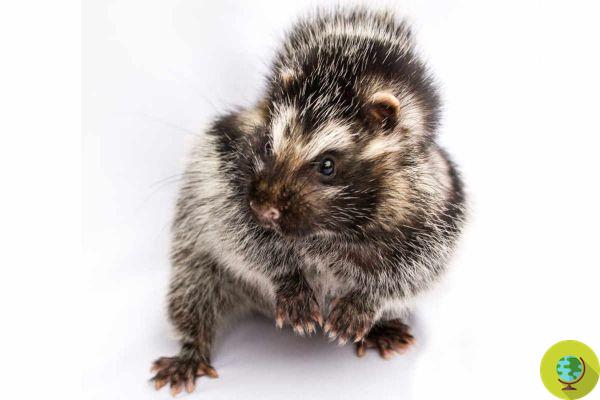
It becomes so poisonous that it can kill even an elephant: it is a tiny, graceful, long-haired East African mouse.
He is about to end up run over, his mother saves himIt becomes so poisonous that it can kill even an elephant: it is a tiny cute little mouse (Lophiomys imhausi) from East Africa with long hair and bushy tail, which looks like a cross between a skunk and a porcupine. However, he does not spray any foul-smelling chemicals nor is his fur so bristly that it is untouchable - the only way to protect himself is eat a poisonous plant (which local hunters have used for hundreds of years to create poison arrows).
The mouse does not ingest the plant, but rather "spreads" it all along its fur, "getting dirty" with toxins that form a real artificial chemical armor against hyenas, wild dogs and any other fairly predator.
The confirmation of its tremendous lethality is recent and described in a study published in the journal Mammalogy, which describes it as thethe only mammal known to harvest plant poison as a means of chemical defense.
According to the researchers, it only takes a few milligrams of the toxin found on mouse fur to kill a human or knock out an elephant.
There are only a few other venomous mammals, such as the male platypus or the American short-tailed shrew. However, the rat in question (Lophiomys imhausi) is the only mammal that derives its toxic chemical defense from an external source. Namely, it extracts toxins from the Alcokanthera schimperi, also known as poisonous arrow tree.
This fantastic little mouse then uses the environment to its advantage, not only for food and shelter, but also for protection: it chews the bark of the tree and then applies the toxic substance to their fur by licking itself. Brilliant.
This behavior was well known among locals, but only recently have researchers led by Sara Weinstein of the University of Utah and the Smithsonian Institution formally documented the venomous fur of the East African crested rat.
In any case, despite carrying deadly poison, they are peaceful herbivores who spend most of their time eating, mating, grooming each other, or climbing walls to reach their nests. They also appear to be monogamous and they share many traits seen in other monogamous animals such as large size, long life expectancy, and a slow reproductive rate.
The elusive African crested rat is not a species of concern to the International Conservation Union (IUCN), the organization that lists species as threatened or endangered. But since there is so little data on these animals, their status is actually in question and, according to local rangers, they may actually be in trouble.
“We don't have precise numbers, but for sure there was a time in Nairobi when cars hit them and there were road accidents everywhere - said Bernard Agwanda, curator of Mammals at the Kenyan Museums. Now meeting them is difficult. Our catch rate is low. Their population is decreasing “.
For the foreseeable future, the team of researchers plans to continue fieldwork in Kenya to better understand the physiology and behavior of these fascinating rats. In particular, scientists would like to know the genetic basis that allow mammals to resist the toxins that would normally have killed them.
Fonte: Mammalogy
Read also:
- Somali elephant shrew rediscovered in Africa after 50 years: believed to be extinct
- The 10 smallest mammals in the world (PHOTO)


























